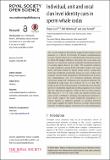Files in this item
Individual, unit and vocal clan level identity cues in sperm whale codas
Item metadata
| dc.contributor.author | Gero, Shane | |
| dc.contributor.author | Whitehead, Hal | |
| dc.contributor.author | Rendell, Luke | |
| dc.date.accessioned | 2016-01-25T13:10:08Z | |
| dc.date.available | 2016-01-25T13:10:08Z | |
| dc.date.issued | 2016-01-01 | |
| dc.identifier | 240445424 | |
| dc.identifier | 013eba7c-bbeb-463c-864b-3e97784848b4 | |
| dc.identifier | 84958073228 | |
| dc.identifier | 000377968600006 | |
| dc.identifier | 26909165 | |
| dc.identifier.citation | Gero , S , Whitehead , H & Rendell , L 2016 , ' Individual, unit and vocal clan level identity cues in sperm whale codas ' , Royal Society Open Science , vol. 3 , no. 1 , 150372 . https://doi.org/10.1098/rsos.150372 | en |
| dc.identifier.issn | 2054-5703 | |
| dc.identifier.other | RIS: urn:794D837379348CC6CEBF5B588AFD3A92 | |
| dc.identifier.other | ORCID: /0000-0002-1121-9142/work/27612539 | |
| dc.identifier.uri | https://hdl.handle.net/10023/8071 | |
| dc.description | Fieldwork was supported by Discovery and Equipment grants to H.W. from the Natural Sciences and Engineering Research Council of Canada (NSERC) and the Whale and Dolphin Conservation Society. S.G. and L.R. were supported by the Marine Alliance for Science and Technology for Scotland (MASTs) pooling initiative and their support is gratefully acknowledged. MASTs is funded by the Scottish Funding Council (grant reference HR09011) and contributing institutions. S.G. was also supported by an NSERC Postgraduate Scholarship (PGS-M), an NSERC Canadian Graduate Scholarship (CGS-D), the Izaak Killam Memorial Scholarship, the Patrick F. Lett Fund, the Dalhousie’s Presidents Award, and an FNU fellowship for the Danish Council for Independent Research from the Ministry of Higher Education and Science supplemented by a Sapere Aude Research Talent Award. | en |
| dc.description.abstract | The ‘social complexity hypothesis’ suggests that complex social structure is a driver of diversity in animal communication systems. Sperm whales have a hierarchically structured society in which the largest affiliative structures, the vocal clans, are marked on ocean-basin scales by culturally transmitted dialects of acoustic signals known as ‘codas’. We examined variation in coda repertoires among both individual whales and social units—the basic element of sperm whale society—using data from nine Caribbean social units across six years. Codas were assigned to individuals using photo-identification and acoustic size measurement, and we calculated similarity between repertoires using both continuous and categorical methods. We identified 21 coda types. Two of those (‘1+1+3’ and ‘5R1’) made up 65% of the codas recorded, were shared across all units and have dominated repertoires in this population for at least 30 years. Individuals appear to differ in the way they produce ‘5R1’ but not ‘1+1+3’ coda. Units use distinct 4-click coda types which contribute to making unit repertoires distinctive. Our results support the social complexity hypothesis in a marine species as different patterns of variation between coda types suggest divergent functions, perhaps representing selection for identity signals at several levels of social structure. | |
| dc.format.extent | 12 | |
| dc.format.extent | 693667 | |
| dc.language.iso | eng | |
| dc.relation.ispartof | Royal Society Open Science | en |
| dc.subject | Social complexity hypothesis | en |
| dc.subject | Conformism | en |
| dc.subject | Individuality | en |
| dc.subject | Communication | en |
| dc.subject | Social structure | en |
| dc.subject | Cetaceans | en |
| dc.subject | GC Oceanography | en |
| dc.subject | QH301 Biology | en |
| dc.subject | QL Zoology | en |
| dc.subject | DAS | en |
| dc.subject | BDC | en |
| dc.subject | R2C | en |
| dc.subject | SDG 14 - Life Below Water | en |
| dc.subject.lcc | GC | en |
| dc.subject.lcc | QH301 | en |
| dc.subject.lcc | QL | en |
| dc.title | Individual, unit and vocal clan level identity cues in sperm whale codas | en |
| dc.type | Journal article | en |
| dc.contributor.institution | University of St Andrews. School of Biology | en |
| dc.contributor.institution | University of St Andrews. Sea Mammal Research Unit | en |
| dc.contributor.institution | University of St Andrews. Marine Alliance for Science & Technology Scotland | en |
| dc.contributor.institution | University of St Andrews. Bioacoustics group | en |
| dc.contributor.institution | University of St Andrews. Centre for Biological Diversity | en |
| dc.identifier.doi | https://doi.org/10.1098/rsos.150372 | |
| dc.description.status | Peer reviewed | en |
This item appears in the following Collection(s)
Items in the St Andrews Research Repository are protected by copyright, with all rights reserved, unless otherwise indicated.

